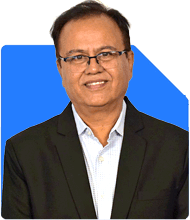Can I build a 5 crore corpus with my income?
Ramalingam Kalirajan |10881 Answers |Ask -Follow
Mutual Funds, Financial Planning Expert - Answered on Feb 12, 2025
He has an MBA in finance from the University of Madras and is a certified financial planner.
He is the director and chief financial planner at Holistic Investment, a Chennai-based firm that offers financial planning and wealth management advice.... more

I'm earning little over to a lakh rupees per month and have been investing 23-25k every month in MF. 25k to my car EMI (which will complete this year by July). I'm 28 years old have dependents at home, maa-paa, wife, and a 6 months old son. I have medical insurance for my family (from my job) and I have two term insurance for myself (1 CR each). Apart from MF I tried LTI in equity but that's around 30 down. What are your suggestions to have 5 CR by the time I turn 50?
You earn over Rs 1 lakh per month.
You invest Rs 23,000 to Rs 25,000 in mutual funds.
You pay Rs 25,000 for a car EMI, which ends in July.
You have dependents: parents, wife, and a 6-month-old son.
You have employer-provided health insurance.
You have two term plans of Rs 1 crore each.
Your long-term equity investment is down by 30%.
Your goal is to reach Rs 5 crore by age 50.
Strengths in Your Financial Plan
Disciplined Investing
You consistently invest Rs 23,000 to Rs 25,000 every month.
This is a good habit for wealth creation.
Adequate Life Insurance
Two term insurance policies ensure financial security for your family.
This is an essential step for dependents' protection.
Employer Health Cover
Your job provides health insurance, reducing medical expense risks.
Ensure it covers all family members adequately.
Areas That Need Improvement
Emergency Fund
Keep at least Rs 3 lakh to Rs 5 lakh in a high-interest savings account or FD.
This should cover six months of expenses.
A solid emergency fund prevents withdrawing investments in a crisis.
Additional Health Insurance
Employer health insurance may not be enough.
Get a personal family floater plan of Rs 10 lakh to Rs 20 lakh.
This protects against unexpected medical costs.
Utilising EMI Savings Post-July
Your car loan ends in July, freeing Rs 25,000 per month.
Redirect this amount into investments for wealth creation.
This boosts your investment power significantly.
Investment Strategy to Achieve Rs 5 Crore
Increase SIP Contributions
Currently, you invest around Rs 25,000 per month.
From August, add the Rs 25,000 saved from the EMI.
This will double your SIPs to Rs 50,000 per month.
Over time, increase SIPs with salary hikes.
Mutual Fund Portfolio Strategy
Continue investing in actively managed funds.
Avoid index funds, as they limit returns in a dynamic market.
Diversify across large-cap, mid-cap, and flexi-cap funds.
Review performance every year and switch if needed.
Public Provident Fund (PPF)
Invest Rs 1.5 lakh per year in PPF.
It provides tax-free, stable long-term returns.
It also balances the volatility of equity investments.
National Pension System (NPS)
Consider investing Rs 5,000 per month in NPS.
It gives tax benefits and disciplined retirement savings.
Equity Investments Beyond Mutual Funds
Direct equity investments are highly volatile.
Continue investing only if you understand the risks.
Otherwise, focus on mutual funds for better management.
Tax Planning for Efficient Growth
Maximise Tax Benefits
Invest Rs 1.5 lakh in PPF under Section 80C.
NPS offers additional deductions under 80CCD(1B).
Choose tax-efficient mutual funds for long-term capital gains benefits.
Mutual Fund Capital Gains Taxation
Long-term capital gains (LTCG) above Rs 1.25 lakh are taxed at 12.5%.
Short-term capital gains (STCG) are taxed at 20%.
Plan redemptions wisely to minimise tax outgo.
Financial Protection for Dependents
Child’s Future Planning
Open a Sukanya Samriddhi Account if you have a daughter.
Otherwise, start a dedicated mutual fund SIP for your child’s education.
Plan for school, college, and higher studies costs well in advance.
Parents’ Health Cover
Consider separate health insurance for parents.
Senior citizen plans cover higher medical costs.
This prevents sudden financial strain.
Final Insights
Increase SIPs after your car EMI ends in July.
Invest in a mix of mutual funds, PPF, and NPS.
Strengthen health coverage beyond employer insurance.
Build an emergency fund before increasing equity investments.
Keep reviewing your portfolio and rebalance if needed.
Best Regards,
K. Ramalingam, MBA, CFP,
Chief Financial Planner,
www.holisticinvestment.in
https://www.youtube.com/@HolisticInvestment
You may like to see similar questions and answers below
Ramalingam Kalirajan |10881 Answers |Ask -Follow
Mutual Funds, Financial Planning Expert - Answered on Jul 30, 2024
Milind Vadjikar | Answer |Ask -Follow
Insurance, Stocks, MF, PF Expert - Answered on Oct 10, 2024
Ramalingam Kalirajan |10881 Answers |Ask -Follow
Mutual Funds, Financial Planning Expert - Answered on Oct 07, 2024
Sunil Lala | Answer |Ask -Follow
Financial Planner - Answered on Jul 23, 2025
Reetika Sharma |423 Answers |Ask -Follow
Financial Planner, MF and Insurance Expert - Answered on Nov 08, 2025
Nayagam P P |10854 Answers |Ask -Follow
Career Counsellor - Answered on Dec 14, 2025
Radheshyam Zanwar |6744 Answers |Ask -Follow
MHT-CET, IIT-JEE, NEET-UG Expert - Answered on Dec 14, 2025
Radheshyam Zanwar |6744 Answers |Ask -Follow
MHT-CET, IIT-JEE, NEET-UG Expert - Answered on Dec 14, 2025
Dr Dipankar Dutta |1840 Answers |Ask -Follow
Tech Careers and Skill Development Expert - Answered on Dec 14, 2025
Dr Dipankar Dutta |1840 Answers |Ask -Follow
Tech Careers and Skill Development Expert - Answered on Dec 13, 2025
Dr Dipankar Dutta |1840 Answers |Ask -Follow
Tech Careers and Skill Development Expert - Answered on Dec 13, 2025
Mayank Chandel |2575 Answers |Ask -Follow
IIT-JEE, NEET-UG, SAT, CLAT, CA, CS Exam Expert - Answered on Dec 13, 2025
Radheshyam Zanwar |6744 Answers |Ask -Follow
MHT-CET, IIT-JEE, NEET-UG Expert - Answered on Dec 13, 2025
Mayank Chandel |2575 Answers |Ask -Follow
IIT-JEE, NEET-UG, SAT, CLAT, CA, CS Exam Expert - Answered on Dec 13, 2025
Mayank Chandel |2575 Answers |Ask -Follow
IIT-JEE, NEET-UG, SAT, CLAT, CA, CS Exam Expert - Answered on Dec 13, 2025

























